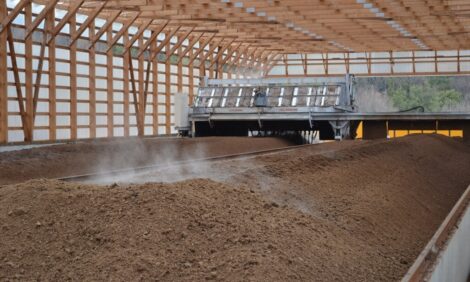



How Zero-tolerance Biosecurity is Beating Bird Flu in the US
The United States has had a good deal of success in containing avian flu outbreaks in recent years – much of it down to a heightened vigilance and emphasis on biosecurity on the part of both the authorities and poultry farmers. As Rachel Lane discovers, the fight doesn’t stop there, with policymakers determined to take it into the backyard...In 2014 and 2015 an outbreak of the highly pathogenic strain of avian influenza H5N2 decimated the poultry industry in the American Midwest. But the episode had another, less harmful effect on the industry: farmers across the United States went from simply being aware of preventative methods to being obsessive in implementing biosecurity. It was the largest known animal disease outbreak of any kind in US history. Since then, every outbreak of AI has been quickly contained, something many credit to farmers’ early detection.
Georgia poultry farmer Russ Moon says he watched in 2015 as new reports of AI came in. The disease spread across the country from the west coast but stopped before reaching the south-east.
“I remember thinking if it ever gets to this area, it’ll be total devastation,” says Moon. “As fast as that stuff is spreading, it’ll be devastating to the economy, to everything.”
He says he has always been careful and proactive about biosecurity, and that the Georgia agriculture community had put an emphasis on disease-presentation even before the 2015 outbreak. But when that outbreak occurred, education and biosecurity were taken to the next level.
“You’re only as clean as your last step and we knew that. But take something as simple as ‘I need a screwdriver’: you run out and grab it and take it back into the house [without taking biosecurity precautions]... Now, once we enter that house with clean feet, we don’t leave until we’re done,” says Moon.
He’s never seen a case of AI first hand, but he’s with the birds three times a day and water consumption is monitored closely. If something is wrong, it’ll be caught quickly. The emphasis on cleanliness has also reduced cases of other diseases on the farm, such as laryngotracheitis, a respiratory infection. Moon says the Georgia Poultry Laboratory Network (GPLN) has been providing education on prevention and information about new outbreaks, trying to stay ahead of any new occurrences of the disease. If a large outbreak does occur, Moon thinks they are ready for it.
The Georgia Poultry Laboratory Network started an email campaign in 2015 and has offered a series of growers’ meetings about AI in the fall of 2015 and 2016, with plans for another programme of meetings in fall 2017. They are in direct contact with the 80 per cent or so of the state’s farmers who attended the meetings in 2015.
For Louise Dufour-Zavala, executive director of the GPLN, AI has always been a concern for her agency. They have studied the disease, how it spreads, how it’s contained and how to respond for the last decade, but since 2015, when 21 states had outbreaks, preparation for highly pathogenic versions of the virus have increased. The result is that this year’s outbreaks in Georgia, Alabama and Tennessee were contained quickly because the farmers recognised the disease and knew how to react.
Different types of the virus effect different types of birds in various ways. The 2015 outbreak started in 2014 with birds infected with the with H5N8 strain migrating from Asia. The birds probably nested in Alaska. The disease then travelled down through Canada to the Pacific coastline and into California. At some point during this trip, the virus mutated to H5N2, which was found in Canada in November 2014. The new version of the virus had five genes from Asia and three from North America, says David Swayne, laboratory director at Southeast Poultry Research Laboratory, which is part of the US Department of Agriculture’s US National Poultry Research Center.
The mutated virus was deadly to chickens but the migratory ducks and geese that probably helped spread the disease did not appear to be ill. At first, the disease was found only in migratory birds, but in January 2015 H5N2 was detected on two poultry farms in California. Swayne said they could tell that these cases were both separate introductions, and had not been spread between the farms. The first few cases in the Midwest were introduced in the same way – by migratory birds – but infection soon started to spread from farm to farm through human activity. The ground outside a barn would be contaminated and brought into the barns on boots, then taken to other farms. Millions of birds died. Farms lost entire flocks, with all the chickens euthanised to try to prevent the spread of the disease. The barns where the contaminated animals lived had to be thoroughly cleaned. It took months to contain and cost billions of dollars.
Since then, says Swayne, an outbreak in Indiana in 2016 and the outbreaks so far in 2017 have been quickly identified and reported. He gives credit to the farmers for keeping the new outbreaks contained quickly.
When an outbreak is reported, every flock, including backyard flocks, within a 10km radius get tested. The Tennessee outbreak in March of this year was a highly pathogenic strain of the disease. During testing of local backyard flocks, low-pathogenic versions were also detected. It’s thought that in this case a low-pathogenic version in a migratory bird mutated when exposed to a low-pathogenic version already active in the local birds and became the highly pathogenic type that was discovered and quickly contained. Swayne says the science allows them to track the different mutations of the virus back to previous versions.
In the 2016 outbreak in Indiana, the disease was discovered most often in ducks, with high concentrations of the virus found in the mouth and cloaca. It transferred easily to other ducks. To be passed on to chickens, they would have to have been exposed in high quantities of the virus and even then it was unlikely to spread to other chickens. Infecting turkeys in the laboratory was found to be easier than infecting chickens but harder than infecting ducks.
While there are vaccines available and more being created, it’s not cost effective to vaccinate poultry against every possible type of AI virus. Regardless of their potential effectiveness, the vaccinations are being sent to the USDA Agriculture’s Animal and Plant Health Inspection Service (APHIS), in case an outbreak like the one in 2015 happens again. The vaccines can only be used if the US Secretary of Agriculture (currently Sonny Perdue) decides there is an emergency. He has stated that some types of vaccines have been used in China and Mexico and other countries. In the US, they have been tested and they have been found to work, but they have not been used in the field.
“Our strategy in the US is to prevent exposure,” says Swayne. “Our main way to prevent is to improve biosecurity.”
Dufour-Zavala says between 90 and 100 per cent of poultry farmers in Georgia, and a similar number nationally, are contracted with poultry companies like Tyson and Perdue. By working with the large companies, she can reach most farmers, but backyard poultry is harder to track. If there is an outbreak in the area, they go door-to-door to every premises within a roughly four-kilometre radius to ask everyone if they have poultry in the backyard. All the flocks, including the backyard flocks, are monitored for several weeks.
She teaches farmers not just how to recognise the disease (by watching water intake and checking to see whether there is a slowdown in egg production): she also talks about visitor control; how to enter a chicken house by disinfecting shoes or boots; how to keep wild birds away; and the importance of not bringing back birds from other areas without taking biosecurity precautions – an issue that could arise if, for example, a farmer went duck hunting.
In the 2017 classes she will offer, she plans to focus on the US Department of Agriculture audit. As part of its National Poultry Improvement Plan, the USDA wants to know about farmers’ procedures in 13 areas, such as “line of separation” – everyone entering a barn should have clean footwear. (All 13 areas can be found in the USDA document ‘National Poultry Improvement Plan Program Standards’, under the heading ‘Standard E – Biosecurity Principles.)
While farmers across the US have clearly been taking steps in the right direction in recent years, adherence to such measures needs to be rigorous right down to the last detail, if outbreaks of strains like H5N2 are to be avoided in future. As Dufour-Zavala says: "Once it’s on a farm, it’s basically a big virus factory."
July 2017








